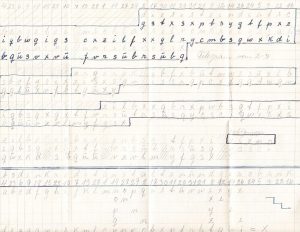23 Jan Herluf Rudolf Alexander Ryel, counterspy
In 1944, as World War II raged in Europe, neutral Sweden was thick with espionage. Representatives of all the combatant nations moved freely throughout the country. Allies and the Germans openly conducted business in the same locales, wining and dining at adjoining tables in the restaurants and bars of the capital. Information critical to the war effort was being bought and sold, and anyone could be a spy.
The U.S. intelligence service, the OSS (Office of Strategic Services), was housed in the farthest back corner of the American Legation in Stockholm. Everyone who worked there had to have a cover, a false reason to be in the neutral country. My mother, Hedvig Johnson, was secretary for William Carlson, head of the OSS X-2 (Counterespionage) division.
In 2009, I made my first trip to the National Archives in College Park, MD, to search for papers related to the wartime activities of my parents. I found a memo dated 4 April 1956 with Hedvig Johnson’s distinctive handwriting and shorthand all over it. The subject of the memo was Herluf Rudolf Alexander Ryel, a gentleman born in Akureyri, Iceland, in 1913.
According to OSS records, beginning in 1930, Ryel traveled back and forth from Iceland to Denmark. He started his own fishing boat business and also went to Germany where he could learn about boat building using the most modern machinery.
Ryel could not help but associate with German Nazis. He worked in Hamburg to build motor torpedo boats. In Berlin he built concrete bunkers. In Denmark, by then occupied by the Germans, he built unarmed “torpedofang” boats, used to retrieve spent torpedos. In Vienna, he worked for the Germans at the Heinkel-Werke constructing a building for the repair of airplanes.
 What Ryel really wanted to do was to return to his home country of Iceland. Since 1918, Iceland had been a sovereign state in union with Denmark. At the beginning of the war, Iceland declared neutrality along with Denmark. Right after Germany occupied Denmark (April 1940), Great Britain invaded Iceland then allowed their ally, the United States, to take control in 1941. Iceland formally became an independent republic on 17 June 1944.
What Ryel really wanted to do was to return to his home country of Iceland. Since 1918, Iceland had been a sovereign state in union with Denmark. At the beginning of the war, Iceland declared neutrality along with Denmark. Right after Germany occupied Denmark (April 1940), Great Britain invaded Iceland then allowed their ally, the United States, to take control in 1941. Iceland formally became an independent republic on 17 June 1944.
Ryel’s German contact (whom he assumed was Gestapo) recruited him to go to Iceland by way of Sweden, then via U-boat.. Once there, his mission was to report on American shipping and on the American armed forces stationed in Iceland. He was given a complex formula for configuring call signals on the wireless.
The OSS report went on to say that once Ryel got to Iceland if he was interrogated by the Americans he was to say that he had escaped from the Organization Todt (a Third Reich military engineering group notorious for using forced labor.) Ryel should state the name of a fishing boat that really did exist and the names of the crew. The Germans would then liquidate the boat and its crew so that no one would be able to question them on the matter. Ryel said he hated this idea and thought it barbaric. He asked his handler if there could be some other plan.

Ryel’s code from the National Archives. I am not sure if this is the code he used with the Germans or one he used with the OSS.
Ryel arrived in Stockholm in July 1944. He went immediately to the Icelandic Legation, introduced himself, and found work. Two or three weeks later at the legation, he met an Icelandic-American to whom he related all about his stays in Germany and how he had come to be in Sweden. This man put Ryel in touch with a contact at the American Legation after which Ryel was shadowed, then interrogated. Ryel reported that he was a German agent awaiting dispatch to Iceland. His German cover name was Rudolph Petersen. Ryel agreed to work for the Americans as a counterspy.
In a report dated 18 August 1944, the OSS reported that Ryel made sketches of the various plants where he worked in Germany and of the wireless school he attended. He gave detailed descriptions of the Germans he had been in touch with. One of particular interest is Dr. V. Rothe, a “specialist in secret writing.” Ryel delivered a copy of his code to the Americans.
The following year, in March of 1945, the memo that my mother dealt with, the OSS was trying to track him down. Was he in Iceland? Stockholm? England? Björn Björnsson, an NBC reporter who worked out of Stockholm, thought he was probably going back to Iceland. Hedvig Johnson’s inquiries noted that he was currently in Göteborg at the address Södra Vägen 38.
This is the end of my research. I do know that Herluf Ryel died in Akureyri, Iceland, in 1993, 80 years old.
I would love to know more …



No Comments